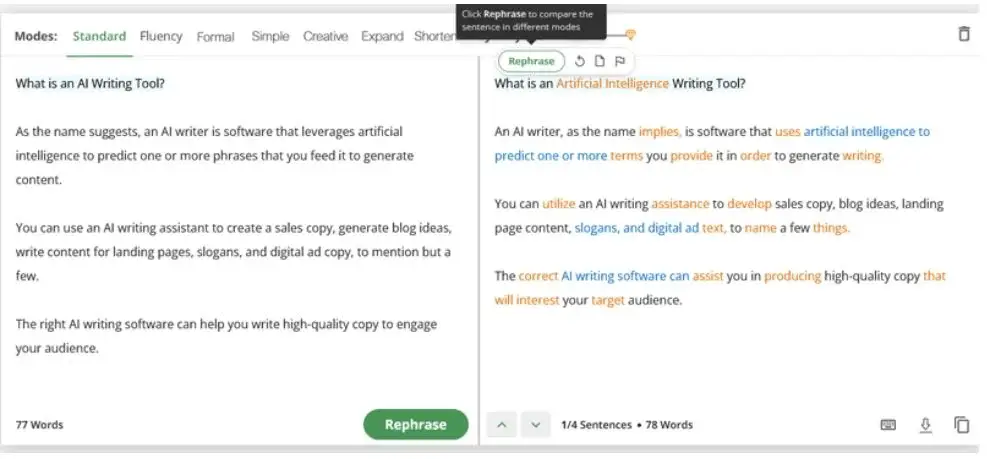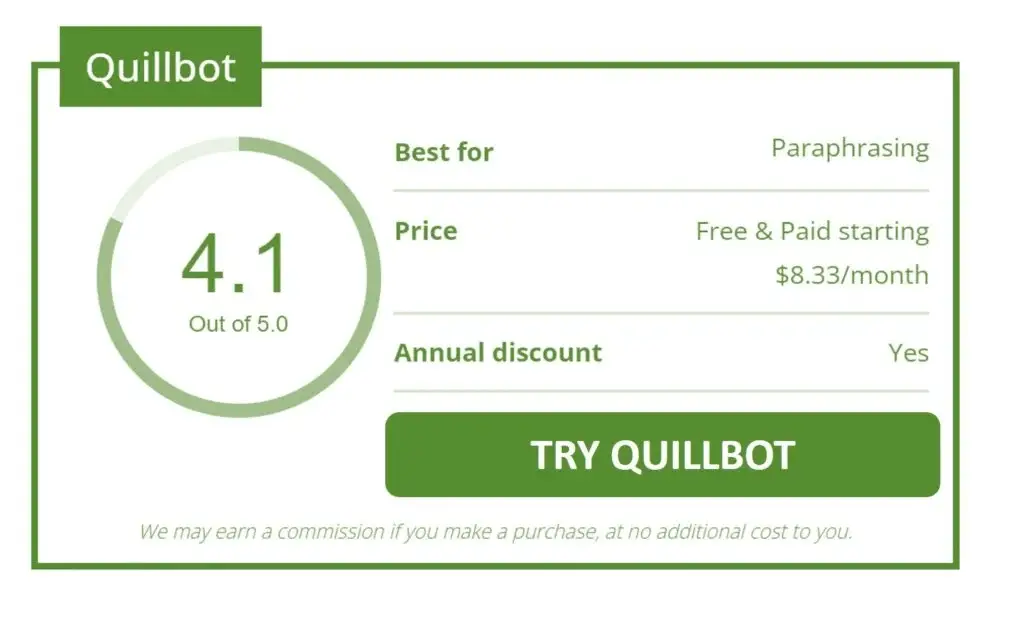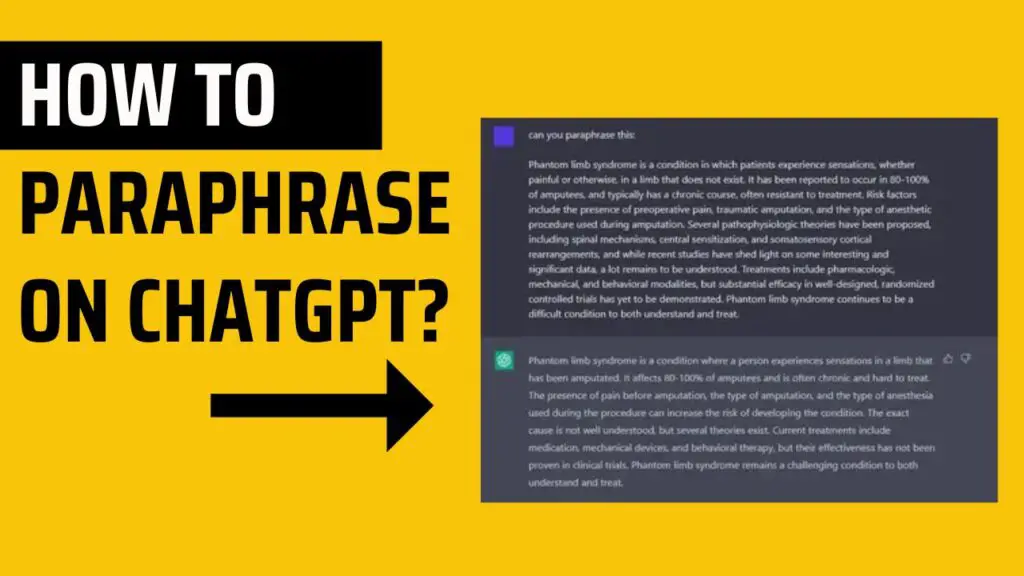In the digital age, content creation is at its peak, and writers often need to paraphrase text to avoid plagiarism and maintain originality. Paraphrasing is the art of rephrasing someone else’s ideas or words while retaining their meaning. With advancements in AI technology, paraphrasing has become more accessible, and one such powerful tool is ChatGPT.
In this blog post, we will explore how to paraphrase text effectively using ChatGPT, along with some practical examples and ChatGPT prompts.
What is Paraphrasing?
Paraphrasing is the process of restating someone else’s words or ideas using your own words while maintaining the original meaning. It allows writers to present information in a new and fresh way, making it an essential skill for content creation.
Read More:
How to Use ChatGPT for Effective Document Review?
12 ChatGPT Prompts for Text Analysis
20 ChatGPT prompts to Write Excel Formulas
10+ ChatGPT Prompts to Write Your Resume
How to Use ChatGPT to Write SQL Queries: Examples and Tips
Importance of Paraphrasing
Paraphrasing is crucial to avoid plagiarism, which can have severe consequences for writers and content creators. By paraphrasing correctly, writers can ensure that their work is original and respect the intellectual property of others.
How does ChatGPT work?
ChatGPT is an AI language model developed by OpenAI. It is designed to generate human-like text based on the given prompts. With its vast knowledge and language capabilities, ChatGPT can be an invaluable tool for writers and paraphrasing tasks.
ChatGPT uses a deep learning architecture to understand and generate human-like text. It has been trained on a wide range of texts, making it versatile in various writing tasks, including paraphrasing.
Read More:
10 ChatGPT Prompts for Job Applications
20 ChatGPT Prompts to Write Code in Python
20 ChatGPT Prompts to Write JavaScript Code
How to Use ChatGPT to Write Your Cover Letter | Prompts
How to Use ChatGPT to Write Code: A Software Developer’s Guide
List of 15+ ChatGPT Prompt Examples for Academic Writing
Using ChatGPT for Paraphrasing
Accessing ChatGPT
To access ChatGPT, you can use the OpenAI website or any other platform that provides access to the model. Some platforms offer free access, while others may require a subscription.
Providing Prompts for Paraphrasing
To paraphrase with ChatGPT, simply input the text you want to rephrase as a prompt. The AI model will then generate paraphrased versions of the given text.
Ensuring Accuracy in Paraphrasing
While ChatGPT is powerful, it’s essential to review the paraphrased content for accuracy. Although it usually provides excellent results, manual review guarantees high-quality paraphrasing.
Read More:
Best ChatGPT Prompts For Students
How to Use ChatGPT to Write a Resume? | Prompts
ChatGPT Prompts for New Business Idea Generation
How to Use ChatGPT to Write a Literature Review With Prompts
7 Ways to Use ChatGPT for Effective Job Interview Preparation
How to use ChatGPT on WhatsApp?
6 Ways to Share ChatGPT Responses With Others
Examples of Paraphrasing text with ChatGPT
Prompt Example 1:
Prompt for ChatGPT: Paraphrase the paragraph below, focusing on the impact of technological advancements on communication, work, and daily life. Simplify the language and maintain the core ideas.
“The rapid advancements in technology have transformed the way we communicate, work, and live. With the rise of smartphones and the internet, information is now readily accessible at our fingertips. Social media platforms have become integral to our daily lives, connecting people from different corners of the world. Additionally, e-commerce has revolutionized the way we shop, offering convenience and a wide range of products.”
Output of ChatGPT:
“The rapid progress in technology has reshaped communication, work, and lifestyle. The prevalence of smartphones and the internet grants easy access to information. Social media platforms play a crucial role in connecting individuals globally. Moreover, e-commerce has revolutionized shopping, providing convenience and an extensive array of products.”
Prompt Example 2:
Prompt for ChatGPT: Rewrite the paragraph below in a more formal tone, without changing the core message.
“Kids these days are addicted to their smartphones. They’re always on social media, and it’s affecting their studies and relationships. It’s a real problem that needs to be addressed.”
Output of ChatGPT:
“The current generation of children is heavily reliant on smartphones, displaying addictive behavior, especially concerning social media engagement. This dependency negatively impacts their academic pursuits and interpersonal connections, necessitating prompt attention and resolution.”
Prompt Example 3:
Prompt for ChatGPT: Rewrite the technical paragraph below in simpler language, making it easily understandable for a general audience.
“The integration of artificial intelligence into our systems has led to a significant improvement in performance and efficiency. AI algorithms analyze vast amounts of data to identify patterns and make informed decisions. This has resulted in enhanced automation, reducing the need for manual intervention and streamlining various processes.”
Output of ChatGPT:
“The incorporation of artificial intelligence in our systems has brought notable enhancements in performance and efficiency. AI algorithms analyze large volumes of data to find patterns and make smart choices. As a result, automation has improved, reducing the requirement for manual involvement and making various processes more streamlined.”
10+ ChatGPT Prompts for Paraphrasing
- “The lazy cat leaps over the swift dog.” – Rephrase the given sentence.
“I just snapped a selfie with my new smartphone, and the camera quality is exceptional!” – Paraphrase this tweet.
- “Company’s New Product Line Announcement Sends Stock Prices Soaring” – Rewrite the news headline.
“In the distant future, a band of young explorers embarks on a mission to protect their world from annihilation.” – Transform the book description.
- “Discover ways to lose weight without strict dieting” – Modify the given phrase.
“One of the fundamental scientific facts is that water reaches its boiling point at 100 degrees Celsius.” – Adapt the scientific fact.
- “An undercover detective infiltrates a criminal organization from within to dismantle it.” – Revise the movie plot.
“Get a chance to win a $50 gift card when you sign up for our newsletter!” – Restate the call-to-action.
- “Recent studies reveal substantial health improvements linked to a plant-based diet.” – Condense the article summary.
- “Many users have experienced adverse effects on mental health due to social media.” – Reformulate the argument.
- “Courage is what matters most, for success is not final, and failure is not fatal.” – Alter the motivational quote.
“Deeds carry greater weight than mere words.” – Rewrite the idiom.
“The saying ‘Fun times fly swiftly’ implies that time seems to pass quickly when one is having a good time.” – Rephrase the saying.
- “Join our exclusive webinar to boost your sales today!” – Modify the email subject line.
- “Audiences were captivated by the movie’s breathtaking special effects and visuals.” – Recast the film review.
- “Blend the eggs, milk, and butter until they form a well-combined mixture.” – Paraphrase the recipe instruction.
- “I am extremely content with the features and performance of my new phone, having recently purchased it.” – Rewrite the testimonial.
“What actions can we take to mitigate the harm caused by climate change?” – Change the question.
How can QuillBot assist you in writing using information from ChatGPT?
QuillBot, a useful paraphrasing tool, can greatly assist you in enhancing your writing when incorporating information obtained from ChatGPT. By utilizing QuillBot alongside ChatGPT, you can ensure that your content remains original and plagiarism-free while effectively presenting the key information derived from ChatGPT’s responses.
When you interact with ChatGPT, it provides valuable insights and responses based on the input you provide. However, using the information directly from ChatGPT may lead to unintentional plagiarism.
With QuillBot’s user-friendly interface and straightforward functionality, you can easily input the text obtained from ChatGPT and receive a revised version that aligns with your writing style and purpose. The tool effectively substitutes words, phrases, and sentence structures, producing a paraphrased output that enhances the flow and coherence of your writing.
Moreover, QuillBot’s algorithms are designed to ensure accuracy and readability. The tool maintains the integrity of the underlying message while presenting it in a more concise and comprehensible form. This enables you to effectively incorporate the valuable insights from ChatGPT into your writing, providing your readers with a clear and engaging presentation of the information.
Example: How can QuillBot assist you in writing using information from ChatGPT?
Let’s consider an example to illustrate how QuillBot’s Paraphraser works in conjunction with ChatGPT. Suppose you input a query into ChatGPT. ChatGPT responds with a detailed and informative answer.
Now, before integrating this response directly into your article or paper, you decide to use QuillBot’s Paraphraser to enhance the originality of the content. You copy the information provided by ChatGPT and paste it into QuillBot’s interface. With a simple click, QuillBot swiftly rewords the text, offering alternative phrasings and synonyms while maintaining the core message and accuracy of the information.

The paraphrased version produced by QuillBot now presents the same key points about the benefits in a unique and distinct manner. The tool replaces certain words and sentence structures, resulting in content that seamlessly integrates with your writing style and the context of your work. By leveraging QuillBot’s Paraphraser, you can confidently include the insights from ChatGPT without any concerns about plagiarism or duplication.

Benefits and Limitations of ChatGPT for Paraphrasing
Advantages of Using ChatGPT
ChatGPT offers efficiency and speed, making it a valuable tool for paraphrasing large volumes of content. It can also help writers overcome writer’s block and generate creative alternatives to existing text.
Applications of ChatGPT in Academic Writing
The applications of using Chat GPT for paraphrasing text in academic writing are diverse and significant. One of the main benefits is ensuring the originality and authenticity of scholarly work. Students and researchers can utilize Chat GPT to rephrase complex ideas, theories, and findings, presenting their concepts in a fresh and unique manner.
Moreover, this AI tool helps avoid unintentional plagiarism by providing new perspectives on existing literature. It also assists in summarizing lengthy research papers or articles, allowing for concise communication without losing the main points. With the help of Chat GPT’s paraphrasing capabilities, academic writers can create well-crafted, plagiarism-free content that adds value to their work.
Applications of ChatGPT in Content Writing
In the field of content creation, Chat GPT’s applications for paraphrasing text are equally noteworthy. Bloggers, copywriters, and marketers can take advantage of this AI technology to revitalize and diversify their content. By paraphrasing existing articles or blog posts, writers can produce new pieces that cater to different audiences or target specific keywords for SEO optimization.
Additionally, Chat GPT assists in generating unique social media posts and product descriptions, enhancing brand presence and engagement. Content creators can also repurpose existing content by rephrasing it into various formats, such as transforming a blog post into an infographic or video script. The versatility offered by Chat GPT in paraphrasing contributes to a more dynamic and engaging content strategy, ultimately leading to greater reach and impact for businesses and individuals alike.
Understanding the Limitations
While ChatGPT is powerful, it may occasionally produce inaccurate or awkwardly phrased paraphrased content. It is crucial to use it as an aid and not solely rely on it for critical tasks.
Tips for Effective Prompt Creation:
- Clarity and Specificity: Ensure that your prompt is clear and specific in conveying the task you want the AI model to perform. Avoid ambiguity and use precise language to articulate the desired outcome.
- Context and Purpose: Provide relevant context and specify the purpose of the prompt. Clearly state what you want to achieve with the AI-generated response.
- Length and Format: Keep the prompt concise and well-structured. Use bullet points or numbered lists to break down complex tasks into manageable steps.
- Use Examples: Include examples to illustrate the type of response you are looking for. This helps the AI model understand the expected output.
- Avoid Leading Language: Refrain from using leading or biased language that could influence the AI’s response. Aim for neutral and objective prompts.
- Consideration of Tone and Style: If you have a specific tone or style in mind, convey it in the prompt. For example, if you want a formal or informal response, mention it explicitly.
- Use of Keywords: Incorporate relevant keywords that are likely to guide the AI model in generating the desired content.
- Iterate and Refine: Don’t be afraid to iterate and refine your prompt if you are not getting the desired results. Experiment with different phrasings to get the best output.
- Test with Sample Inputs: Before using the prompt in a critical task, test it with sample inputs to see how the AI model responds. This allows you to fine-tune the prompt if needed.
- Consider Task Difficulty: Be mindful of the complexity of the task. For more challenging tasks, consider breaking them down into smaller, manageable prompts.
- Balanced Information: Provide enough information in the prompt without overwhelming the AI model. Strike a balance to ensure it can generate accurate and relevant responses.
- Avoid Over-specification: While clarity is important, avoid over-specifying every detail. Let the AI model demonstrate its creativity within the given context.
- Task Validation: After receiving the AI-generated response, validate the output to ensure it aligns with your requirements and meets the desired quality.
Conclusion
Paraphrasing is a crucial skill for writers, and with the help of AI tools like ChatGPT, it has become more accessible and efficient. However, writers should use these tools responsibly and supplement them with manual review to ensure accuracy.
Other articles
Please read through some of our other articles with examples and explanations if you’d like to learn more.
Tools
- QuillBot
- Paraphraser.io
- Imagestotext.io
- Websites to Read Books for Free
- Tools to Convert PNG Image to Excel
- Detect AI-Generated Text using ZeroGPT and Transform It using Quillbot
- How is QuillBot used in Academic Writing?
- Tools for Presentations
- AI Tools for Citation Management
- Improve your Writing with QuillBot and ChatGPT
- Tools Transforming Knowledge Management
- Plagiarism Checkers Online
- Information Management Software
- Tools for Information Management
- Software Tools for Writing Thesis
- OpenAI WordPress Plugin
- TTS Voiceover
- Backend Automation Testing Tools
- AI Tools for Academic Research
Tech Hacks
Technology
- Shorten the Content’s Length Without Lossing its Meaning
- Write Scientific Research Paper Using Google Bard AI
- Google Bard Can Create Spreadsheets
- How AI Technology is Helpful For Marketers
- How AI Chatbots Can Identify Trading Patterns
- Quorum vs Hyperledger Fabric vs R3 Corda
- ChatGPT vs. Google Bard
- Quantum Apocalypse
- Firmware and Software
- Synergy vs. KVM Switches
- Flash Drive Vs Pen Drive
- Type A, B and C USB Cable
- WSN and IoT
- eSourcing and eProcurement
- Difference between eProcurement and Traditional Procurement
- Neuralink
- ReactJS
- Over the Top and Video On Demand
- Software Development Life Cycle Vs Software Testing Life Cycle
- Software Development Team vs Freelancer
- HDMI over IP vs HDBaseT
- Display Stream Compression
- Top Internet of Things Journals
- Supervised Learning vs. Unsupervised Learning
- Video Upscaling and Video Downscaling
- How To Build a Distributed System
- How to Get Into Data Science From a Non-Technical Background?
- How To Build Ethereum Mining Rig?
ChatGPT
- Paraphrase Text
- PowerPoint Slides
- Learn Languages
- Write Code in Python
- Write Literature Review
- Document Review
- Job Interview Preparation
- Prompts For Students
- Write Cover Letter
- Write Resume
- Write Code
- Job Applications
- Write SQL Queries
- Write Excel Formulas
- Academic Writing
- Translate Text
- Keyword Research
- Business Idea Generation
- Business Entrepreneur
- Use ChatGPT on WhatsApp
- Virtual Research Assistant
- Meta-Analysis in Research
- Large Documents
- Hypothesis Development
- Share ChatGPT Responses
- Text Analysis
- Upload PDF on ChatGPT
- Books ChatGPT



